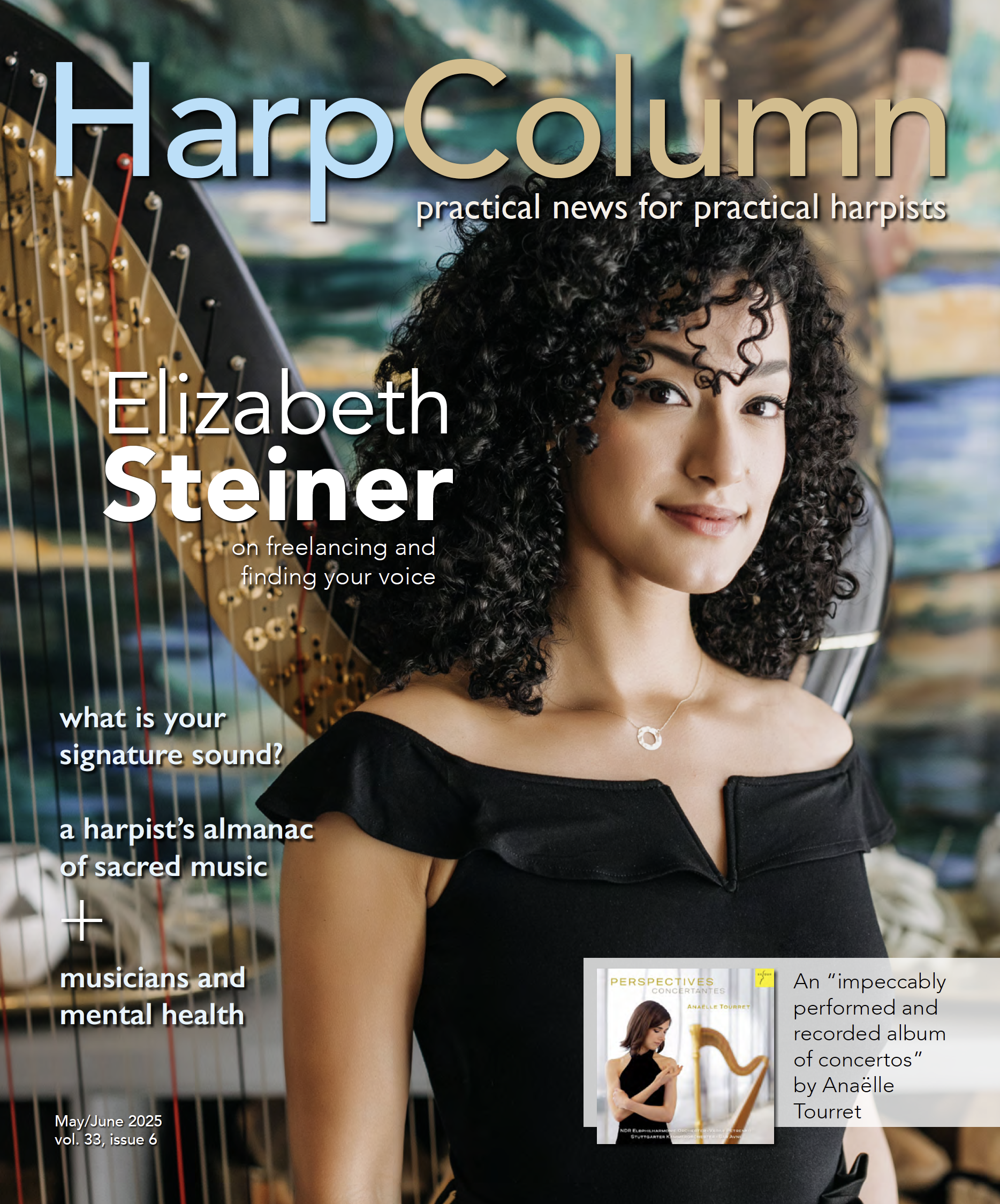Home › Forums › Teaching the Harp › Harp Technique for females?
- This topic has 17 replies, 8 voices, and was last updated 15 years, 11 months ago by
tony-morosco.
-
AuthorPosts
-
May 22, 2009 at 2:18 pm #85751
unknown-user
ParticipantHas anyone ever looked into the best technique for female harpist? I know that Salzedo mainly had female students, and Lucile Lawrence was a strong proponent of his technique. Of course, Grandjanny was also a man. Is there a technique that is more conducive to tendinitis?
I originally started with Grandjanny, but personally like the sound and tone gained from the more natural bent fingers, which to me seem to place more of the string on the fat fleshly part of the tip, rather then the smashed finger tips which cause more bone to hit the string and thus produce a harsher sound.
I appreciate in help you can give me in this matter. Thanks.
May 22, 2009 at 2:44 pm #85752Misty Harrison
ParticipantGreat question. All the major schools have many successful female students and are good. Always it seems to me Renie’s method book and technique are good for smaller hands and bodies but Grandjany was her student.
If you’re really worried about this, best thing to do is not worry about the school and instead find a teacher with a similar physical size to you and make sure the teacher plays the way you want to play. If you like hearing her play and want to play like her and she has a body like yours then you will get a lot out of that.
All the same many harpists study with people larger or smaller than themselves and turn out fine.
May 22, 2009 at 5:27 pm #85753carl-swanson
ParticipantI agree with Misty. But I have to clarify one point you made, and that concerns playing with “flattened” fingers. I know Grandjany played that way, as did my teacher, Pierre Jamet. But neither of these men insisted on it for their students. it was their personal preference, and my last teacher, Bernard Zighera, who had studied at the Paris Conservatory under Tournier, didn’t play that way. So my question is, did Grandjany insist that you play with flattened fingers?
May 23, 2009 at 3:55 am #85754Misty Harrison
ParticipantSometimes I find more control with curved fingers
May 26, 2009 at 5:46 pm #85755Saul Davis Zlatkovski
ParticipantMy fingertips are so smashed that the bone has ground down to just a nub above the knuckle, hence I have a very fleshy tone!
But seriously, I think you grossly misinterpret harp technique. I see no technical difference between genders, only how it is used. It seems like more women have longer and thinner fingers that may lead to greater facility, or those are the ones who more visible. Small hands aren’t particularly helpful in playing the harp. Big hands with big fingers lead to plush tone, which I have observed in men and women.
My hands are the same size as Miss Lawrence’s were, but her fingers were longer and her palm smaller, my palm is bigger, but fingers not as long. We had the same reach at the time.
The technique that is most conducive to developing tendinitis is the one that allows playing with a lot of tension, with I think excessive wrist motion, rigid posture and restricted movement, clenching fingers not being used while playing with the others, and over-practicing. That kind of technique occurs in any schooling.
I do think men, or harpists with “man-sized” hands have the strongest tone, usually, unless one smaller strives for it. Marilyn Costello had bigger hands than mine, as I remember, and Zighera and Salzedo both had big, big hands.
As for the best technique for a female, Miss Lawrence used to say, “you have to be able to play like a man”, a still-legitimate comment as in ensembles you must be able to blend and balance with strong players, male or female. A strictly “feminine” approach to interpretation does not serve the music well. Nor strictly “masculine” either. One must have both. Perhaps the age of tyrant conductors is past, but it could return, and you need to be tough to endure them.
I will say that too much flesh on the string both inhibits facility and produces a tone I would call dull, less colorful and clear with less definition, in my opinion. But that is like putting the string in the middle of one’s finger.
May 27, 2009 at 5:35 pm #85756Saul Davis Zlatkovski
ParticipantGrossly must have come to mind because of how you used “smashed finger tips”.
May 28, 2009 at 1:32 pm #85757unknown-user
ParticipantI first of all, want to say thank you to all that have answered this posts so far. It has been greatly helpful. Perhaps I should give some additional information. I am a harp teacher that had a student come down with a severe case of tendinitis. She had to stop playing all together because of pain. We have consulted with an excellent doctor and have found that posture, position and some other things were part of the factor. It was suggested however, by another (female) harpist that woman often have to compensate for the muscles of a man, and that the Grandjanny Technique might be more conducive to women, and that Salzedo is more of a man’s technique.
I prefer a combination, certainly don’t like the rigid 5th finger, but allow it to follow. I have been taught in a combination of Renie, Grandjanny, and Salzedo. Also it seems that by now what is a pure technique. Each teacher mixes a bit of their own experience in.
Perhaps finger tips was not the best wording to use, but I personally don’t like that style, but then it is not my intention to start a battle of Gradjanny vs. Salzedo. I simple was wondering if anyone had come across something like this or if there is any fact to one being more conducive to tendinitis. Thanks, and I will continue to listen.
May 28, 2009 at 4:40 pm #85758Misty Harrison
ParticipantIt’s too bad someone said that about Grandjany versus Salzedo, since both had many female students who have been extremely successful.
I really think if this is a concern that you should send the student to a teacher who does harp and Laban movement analysis or ergonomics or Alexander Technique or body mapping, and also consider having the student work with a harpist who is the same size she is but who does not have a history of similar injury. That harpist probably has a technique fit for size regardless of the playing school he or she studied.
May 29, 2009 at 3:25 am #85759Saul Davis Zlatkovski
ParticipantTendinitis comes from inflammation and playing while very tense. I have seen tense players in many schools of technique. It has a lot to do with both personality and genetic susceptibility, and underlying health problems. Muscle weakness can be a factor in a student applying the wrong kind of pressure. There is no rigid 5th finger in any technique I know of. Doctors rarely understand the processes of playing, in my experience.
I would say the student needs a break, to let the tendon sheaths calm down with rest, stretching, and medication, then she needs to build her upper body strength with careful exercise, then resume playing in a calm fashion, with good posture and a sense of relaxation. She should also have thorough examinations to exclude conditions such as fibromyalgia.
I tell my students to relax their fingers as they leave the strings, to release the pressure as they play. Tendinitis is also something that flares up from time to time, but is not a permanent condition. If your student really wants to know what condition she is in, she should have an ultrasound radiologist examine her soft tissue to pinpoint the trouble spots.
May 29, 2009 at 3:28 am #85760Saul Davis Zlatkovski
ParticipantI disagree with Misty, as a harpist who has experienced tendinitis and learned how to cure it or adapt is more knowledgable than someone with no experience of it. They may simply have a more durable physique. Singers all have the same vocal cords, but some are like iron, and others are fragile.
Tai Chi, all those movement programs are helpful in their own way, but analysis of harp playing should be done by harpists, I think.
May 29, 2009 at 3:30 am #85761Saul Davis Zlatkovski
ParticipantIt is true that certain women might develop physical problems from compensation, but we are mostly all capable of exercise and building strength, which will produce the desired results. Miss Lawrence was no more than 5’4″, but she was very strong. When she was young she did a lot of swimming and riding, I know. I think she always ate well, too.
June 10, 2009 at 11:30 pm #85762Geri McQuillen
ParticipantJust a little anecdote…. Before I started playing harp, I attended a meeting hosted by a harp teacher to introduce the harp and recruit students.
June 12, 2009 at 8:54 pm #85763tony-morosco
ParticipantDepends on the type of harp. Smallish lever harps can be played this way, and in fact this is not uncommon
June 13, 2009 at 5:44 pm #85764tony-morosco
ParticipantHere are some images of Mary O’Hara showing how she sat at the harp. These are publicity photos, but I have seen video of her play and this is how she sat when she played as well. (the first is a bit exaggerated with the harp a bit farther to the side that she typically sat, but generally it is how she sat)

 June 13, 2009 at 6:13 pm #85765
June 13, 2009 at 6:13 pm #85765harpglo-jean
ParticipantYes, and you can actually see her playing this way (quite nicely) in a few videos on YouTube.
-
AuthorPosts
- You must be logged in to reply to this topic.






